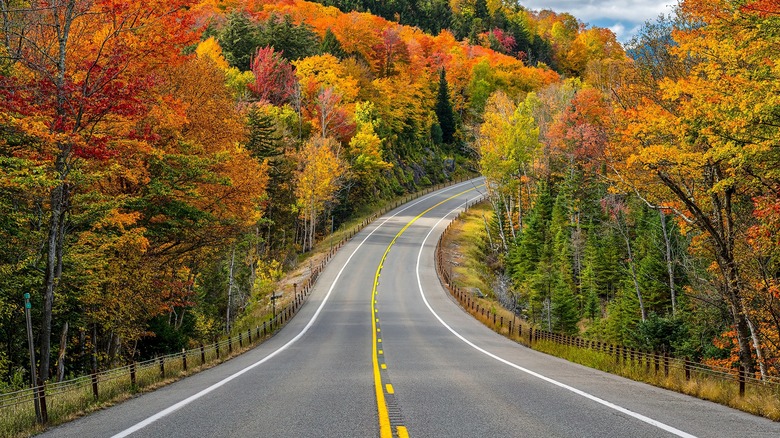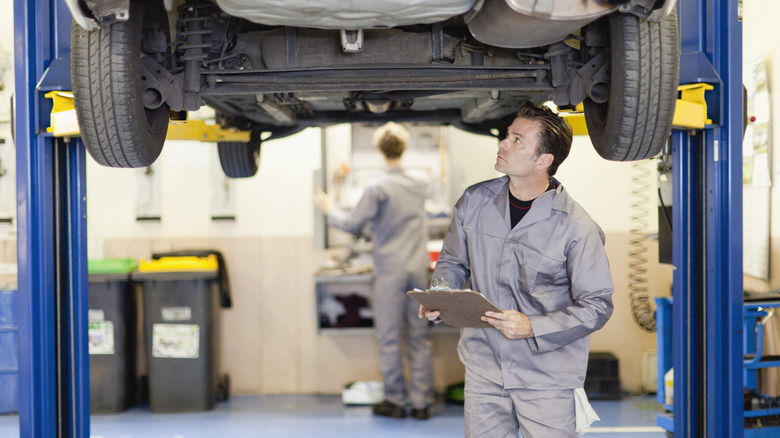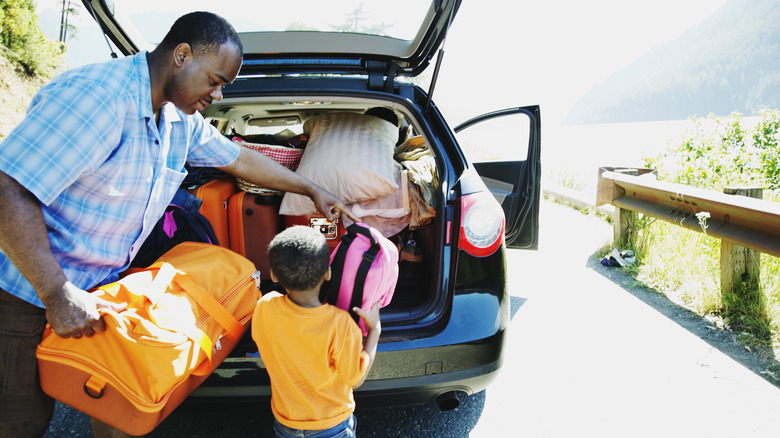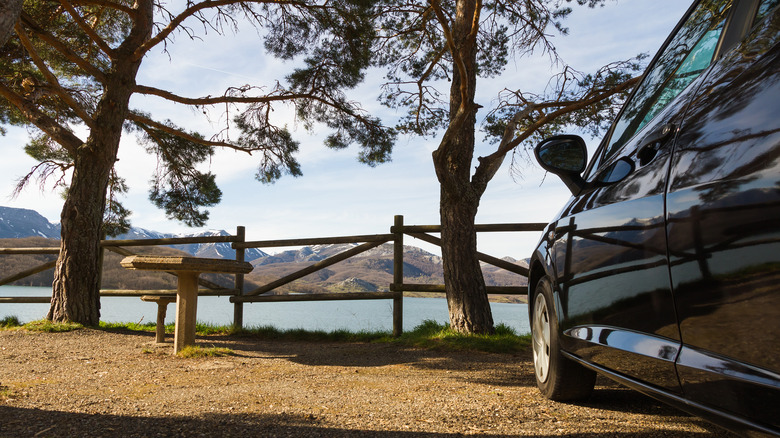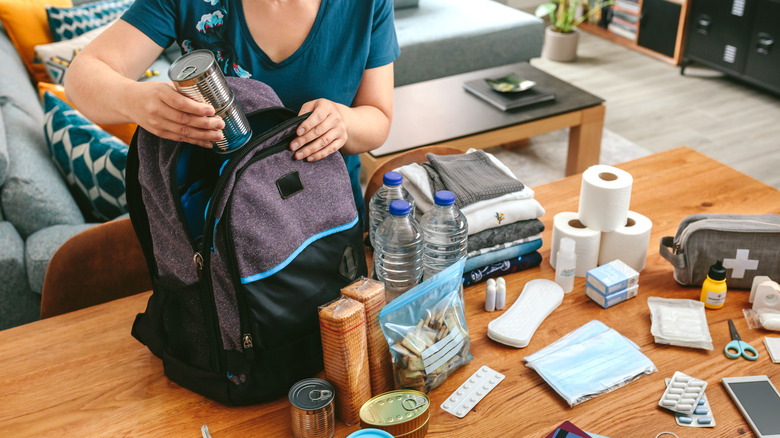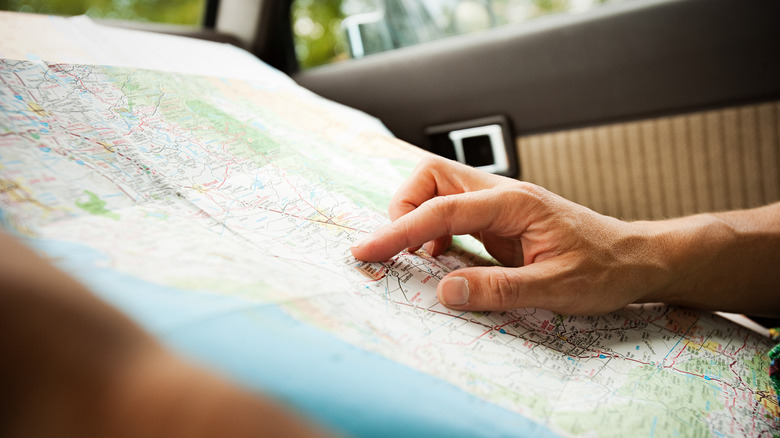The 5 Most Important Safety Precautions You Should Take Before A Road Trip
The COVID-19 pandemic created a surge of folks trying to vacation safely which, for a lot of people, meant a resurgence of the road trip. Even in March 2022, road-tripping was still one of the most popular modes of vacation transportation. According to Travel Pulse, 80% of travelers said they were going to be road-tripping later in the summer. Even with historic gas prices, Americans were still taking to the road for their adventures, per The New York Times.
"Historically, gas prices have had very little, if any impact on travel," Cheryl Schutz, vice president of travel insights at MMGY Global, told the outlet. "People may change what they spend money on, but they will still travel." Although how much one spends on gas on a road trip is part of the preparation, there are other elements to be considered as well (and yes, we mean besides the hoard of road trip snacks). There are essential safety measures that need to be taken before you hit the open highway.
Get your vehicle ready
Obviously, the car is the biggest piece of a road trip puzzle, which means it needs to be tended to. SafeMotorist suggests taking care of your car preparations at least a month before departure just in case something goes awry. They suggest checking all your fluid levels (think coolant and oil), making sure your spare tire is in good shape, and doing an inspection of all your hoses/filters/etc.
"Make sure that you're up to date on all of the maintenance for your vehicle," Bryan Rogala told Gear Patrol about road trip advice. "A fresh oil change, checking the fluid levels. As cars get newer and more difficult to work on yourself, some of those basic skills get glossed over. But you can really save yourself a lot of headaches just by checking your tire pressure and making sure you're not low on oil, and making sure you've got enough windshield washer fluid."
Preparing a car for a long trip might take a while, but it's certainly better than not having a replacement tire 12 hours into a 30-hour drive. A little extra care with your road-tripping vehicle can lead to a successful adventure for all.
Strategically pack the car
Besides packing snacks within reach, having charging cables on hand, and making activities for passengers accessible, there are considerations to be made about how to pack the car. Among some of the key packing strategies are keeping views unobscured for the driver, placing the heaviest bags on the bottom so they cannot fly forward, and strapping down luggage to keep it in place (per Arrive Alive).
"Packing a car is a blend of art and science that helps protect everyone on the road," McIntyre Schultz told Popular Science. He further explained that the kind of vehicle you plan on driving makes a lot of difference in your packing considerations. "A trunk provides a natural separation for passengers from luggage, heavy, or loose gear and can minimize distractions caused by items shifting mid-drive," he told the outlet. Both Popular Science and Arrive Alive reiterated the importance of consciously packing — overstuffing a vehicle can be dangerous as any items can become projectiles. Not to mention that weight distribution affects a car's gas mileage.
Give yourself breaks
When you've given yourself a travel itinerary, it can be hard to deviate from it — even if it means taking breaks during a road trip. However, not taking breaks can be extremely dangerous. Not only can pushing through be damaging to your stamina, but it's also hard on your body. According to MotorBiscuit, driving for extended periods of time can increase your risk of developing sciatic nerve pain, especially if you're an older adult. Further, the outlet suggests stopping for a rest at a well-lit rest stop or large gas station if you can for added safety.
The Road Trip Expert suggests stopping for at least 15 minutes every two hours and limiting yourself to nine hours of driving in a single day. The outlet says 12 hours in a day is possible with multiple drivers but not recommended. Stopping every few hours can help reduce back pain if riders can stretch and move around during that rest time. Although the destination is probably the most fun part of a vacation, there's no reason you can't enjoy the journey too! Take those breaks.
Refresh your emergency kit
Not anticipating emergencies ahead of time could put you in a dangerous position on your road trip. It's a good idea to always have some emergency supplies in your vehicle anyway, but it's doubly important when you're spending hours upon hours on the road. Traction News says being prepared is becoming more important for drivers because of the rising frequency of extreme weather phenomena. Their most essential safety items include tire patch kits, blankets, water, flares, and first aid materials.
In a piece for Roadtrippers, Karuna Eberl and Steve Alberts, a couple of million-mile road-trippers, suggested a few more practical items for a road-trip emergency kit. They suggested having some tools like a wrench and screwdriver in the car for basic repairs, extra fluids for the car, jumper cables, and work gloves. It's also a good idea to have an external battery pack to keep phones going in an emergency situation if the car dies. You never know when these things will come in handy!
Bring a map
Whether the weather has killed phone signals or you're driving out of range for your carrier, phone maps don't always work when we need them to. To avoid becoming irrevocably lost, it's best to have a paper map on hand just in case. Not only can a paper map help in case of emergencies, but it can also help in ways that technology cannot. Car and Driver note that if an app like Google Maps has a weak signal, the terrain mapping feature becomes nonexistent. The outlet also notes that a paper map would help drivers know when treacherous terrain is coming up if their phone can't.
USA Today reports that AAA members can still request TripTiks through their local branch, which is a notebook with maps tracking the member's road-tripping route. Printed maps also offer alternatives in bad situations. "When we were in Nebraska last year with all the flooding, a paper map would have been helpful when both Apple and Google Maps told us to go down a flooded road," Barb Gonzalez, a travel photographer and writer, told USA Today. So tuck a paper map into the glove compartment ahead of a big road trip. They don't take up much space and can really help drivers in a bind.
